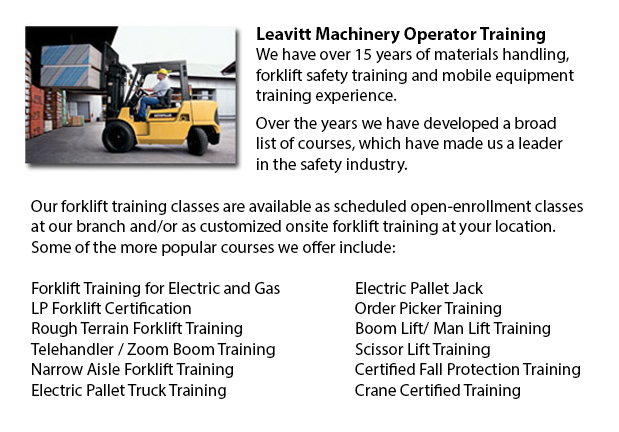
Rough Terrain Forklifts Training Kitchener - There are in fact two categories of lift trucks within the manufacturing business, the rough terrain model and the industrial version. Rough terrain forklifts appeared in the 1940's built predominantly for use on irregular surfaces, best for lumberyards and construction sites, offering lifting muscle when there was no paved surface accessible.
Rough ground lift trucks typically employ an internal combustion engine with a battery for power. The engines can function on propane, diesel or gas. Many makers are playing with rough terrain forklifts that utilize vegetable matter and run from ethanol. Substantial pneumatic tires with deep treads distinguish these vehicles to allow them to grab onto the roughest ground type devoid of any slippage or shifting.
The initial designs of all terrain lift trucks were able to carry weights of up to 1000 lbs, via blades that could slide beneath the item, raise it a slight bit and then transfer it to an alternate location. After some time on the market, all terrain vehicles had been given additional shipping power to about 2000 lbs capacity. In the 1960's telescoping booms were added, allowing them to stack supplies a good deal higher than in earlier years. The telescoping design characteristic is a staple of most rough terrain lift trucks nowadays. Present designs are capable of handling well over 4000 lbs due to the constant improvements over time. Telescoping ability has also improved with some models reaching a height of 35 feet. Operator safety has also become a focus with a lot of all terrain lift trucks currently developed are outfitted with an enclosed cab for the operator, versus the older open air seating capacity.
The rough terrain forklifts existing these days work just as well on covered floors as on unpaved roads. These rough terrain lift trucks are being marketed for their adaptability permitting businesses to move items from outside the facility to the inside or vice versa.
-
Pallet Lifts
Pallet Lifts Training Kitchener - A pallet lift is a model of equipment specialized in the maneuvering of pallets of various dimensions and weights. They might be utilized as an accessory for platform lifts, cranes and other kinds of heavy machinery... More -
Scissor Lifts
Scissor Lift Training Kitchener - The scissor lift or platform lift, is a mechanical industrial lift that may be customized to be used in retail, wholesale, manufacturing and production settings. Industrialized scissor lifts have been used mainly wit... More -
Reach Trucks
Reach Truck Training Kitchener - Reach trucks are loading machines used by different types of companies that sustain a storeroom facility or circulation center relating to the organization of finished goods and supplies on pallets which are inserted... More -
Crown Forklift
More -
Terex Forklift
Terex Forklift Forklift Training - Terex Forklifts stands by their goal to supply a dependable and cost effective product line. They take pride in making equipment that improves their customers' earnings. Through numerous divestures and acquisitions... More

Forklift Certification Kitchener
TOLL FREE: 1-888-254-6157
Kitchener, Ontario
forkliftcertificationkitchener.com
Email Us
About Us


